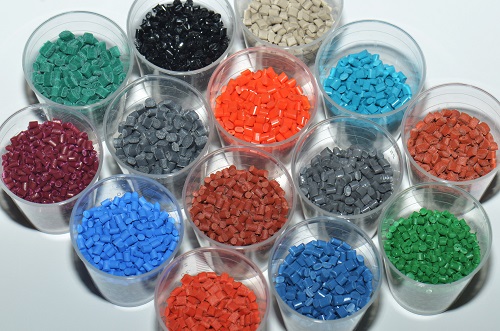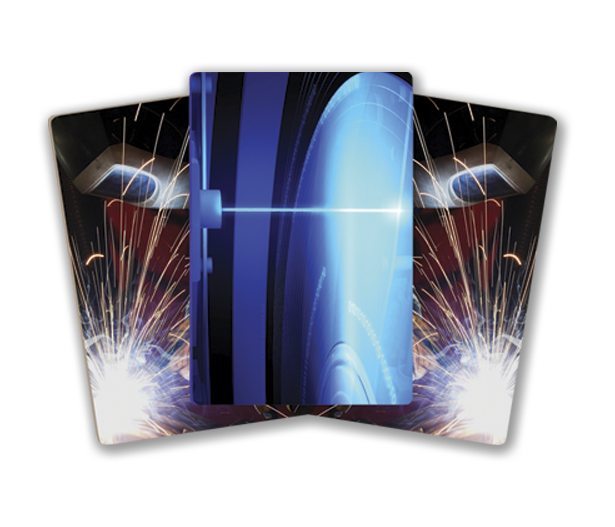To choose injection molding material, consider application needs, aesthetic requirements, environmental impact, processing properties, and regulatory standards.

Plastic Types
Thermoplastics vs. Thermosetting Plastics
Thermoplastics are a type of plastic that becomes soft when heated and hardens upon cooling. This property allows them to be remelted and reformed multiple times, making them highly versatile for various applications. Some common examples of thermoplastics include:
- Polyethylene (PE)
- Polypropylene (PP)
- Polystyrene (PS)
- Polyvinyl Chloride (PVC)
Key Characteristics of Thermoplastics:
- Can be recycled
- High-impact resistance
- Suitable for injection molding
- Versatile in application due to re-moldability
Thermosetting Plastics, on the other hand, once molded and set, cannot be remelted or reformed. They possess a three-dimensional network of bonded atoms, giving them high heat and chemical resistance. Common thermosetting plastics include:
- Epoxy Resins
- Phenolic Resins
- Melamine Resins
- Urea-Formaldehyde
Key Characteristics of Thermosetting Plastics:
- Cannot be remolded or reshaped once set
- Offer high heat and chemical resistance
- Commonly used for electronics and composites
Commonly Used Plastics in Injection Molding
Injection molding is a common process to produce plastic parts in large volumes. The choice of plastic material largely depends on the end application, cost, and desired properties of the final product.
- Polyethylene (PE): Widely used due to its flexibility, chemical resistance, and affordability. Often seen in bottles, toys, and containers.
- Polypropylene (PP): Known for its high melting point and resistance to chemicals, making it ideal for automotive parts and packaging.
- Polystyrene (PS): Commonly used in disposable cutlery, CD cases, and cosmetic packaging due to its ease of processing and clarity.
- Polycarbonate (PC): Renowned for its high impact resistance and clarity, often used in eyewear lenses, CD/DVD discs, and medical devices.
- Polyvinyl Chloride (PVC): Popular for its durability and cost-effectiveness. Used in piping, cable insulation, and vinyl flooring.
Aesthetic Considerations
In the realm of product design and manufacturing, aesthetics play a pivotal role. Not only do aesthetic considerations impact a product’s appeal, but they also influence its functionality and user experience. When it comes to plastics and injection molding, several aesthetic factors come into play:
Color
Choosing the right color for a product can set its tone, mood, and overall perception. Plastic materials offer vast possibilities in terms of coloration:
- Pigmented Plastics: Manufacturers often add colorants or pigments to the raw plastic material to achieve the desired hue. The color consistency is crucial, especially for brand identity and recognition.
- Natural or Neutral Plastics: These are plastics without added color, often appearing white or translucent. They’re ideal for products that require painting or further surface treatments.
- Special Effects: Some plastics come with embedded glitter, glow-in-the-dark properties, or other unique effects to enhance visual appeal.

Transparency
Transparency in plastic products can offer both functional and aesthetic benefits:
- Clear Plastics: Materials like polycarbonate (PC) and acrylic are transparent, making them ideal for applications like eyewear lenses or transparent barriers.
- Translucent Plastics: These allow light to pass through but not detailed images. They’re suitable for products that need to diffuse light or offer a frosted appearance.
- Opaque Plastics: These do not allow any light to pass through, ideal for products that require concealment or protection from light.
Surface Finish
The surface finish of a plastic part can drastically affect its look and feel:
- Glossy Finish: This gives the product a shiny and sleek appearance. It’s popular in consumer electronics and decorative items.
- Matte Finish: Offering a non-reflective surface, matte finishes are often chosen for a more subtle and refined look.
- Textured Finish: Textures can provide a tactile experience, enhance grip, or hide manufacturing imperfections.
Cost and Availability
The cost of materials and their availability can significantly impact the decision-making process in product manufacturing:
- Economical Options: Materials like polyethylene (PE) and polypropylene (PP) are relatively affordable and widely available, making them popular choices for mass-produced items.
- Specialized Materials: Some plastics offer unique properties but might come at a higher cost or be less available. For instance, specialized transparent plastics or those with high-performance attributes might be pricier.
- Supply Chain Considerations: Ensuring a consistent supply of the chosen material is crucial. Sudden shortages can disrupt production timelines and increase costs. It’s always wise to have backup suppliers or consider local vs. international sourcing based on cost, quality, and availability.
Material Selection Based on Application
Different applications require distinct material properties. When it comes to injection molding, choosing the right plastic can dictate the success, longevity, and functionality of the product. Here’s a look at some popular applications and the ideal plastic materials for them

Consumer Electronics
The world of consumer electronics demands materials that are durable, lightweight, and sometimes even transparent:
- Polycarbonate (PC): Chosen for its high impact resistance and optical clarity, PC is ideal for making eyewear lenses, smartphone cases, and even CD/DVD discs.
- Acrylonitrile Butadiene Styrene (ABS): A popular choice for its strength and durability. It’s used in making the casings of televisions, keyboards, and gaming consoles.
- Polyphenylene Sulfide (PPS): With its ability to withstand high temperatures, PPS is excellent for components inside electronics like connectors.
Automotive Components
The automotive industry requires materials that can withstand various stresses, temperatures, and environmental factors:
- Polypropylene (PP): Due to its resistance to fatigue, PP is widely used for making car bumpers, interior trims, and dashboards.
- Polyamide (PA or Nylon): Known for its strength and heat resistance, Nylon is used in under-the-hood applications like engine covers and air intake systems.
- Polybutylene Terephthalate (PBT): Chosen for electrical connectors and sensors because of its electrical properties and heat resistance.
Medical Devices
Materials used in medical devices need to be biocompatible, sterilizable, and sometimes transparent:
- Polyetheretherketone (PEEK): Renowned for its biocompatibility and strength, PEEK is used in surgical instruments and implants.
- Polystyrene (PS): Being easy to mold and clear, PS is often the choice for lab equipment like petri dishes and test tubes.
- Polyvinyl Chloride (PVC): Commonly selected for medical tubing and blood bags due to its flexibility and biocompatibility.
Packaging Solutions
The packaging industry values materials that are versatile, protective, and sometimes biodegradable:
- Polyethylene (PE): Flexible and durable, PE finds its use in making plastic bags, wraps, and bottles.
- Polystyrene (PS): With its clarity and rigidity, PS is used in making clear clamshell packaging and food trays.
- Polyethylene Terephthalate (PET): Known for its clarity and barrier properties, PET is the choice for beverage and food containers.

Household Items
Everyday household items require materials that are durable, easy to mold, and sometimes aesthetically pleasing:
- Polypropylene (PP): Being heat-resistant and durable, PP is popular for kitchenware like bowls and microwave-safe containers.
- Polycarbonate (PC): Its clarity and strength make it suitable for items like water pitchers and storage containers.
- Acrylonitrile Butadiene Styrene (ABS): With its combination of strength and aesthetics, ABS is a go-to for toys, tool handles, and many other household items.
Environmental and Sustainability Considerations
As the world gravitates towards more eco-friendly practices, the plastic industry is not left behind. Environmental and sustainability considerations are becoming paramount when selecting materials, particularly in the realm of injection molding. Factors such as biodegradability, recyclability, and the carbon footprint of production play significant roles.
Bioplastics and Eco-friendly Options
Bioplastics are derived from renewable sources like corn starch, sugarcane, or even algae. Unlike traditional plastics, which are petroleum-based, bioplastics can help reduce the carbon footprint and dependence on fossil fuels:
- Polylactic Acid (PLA): Derived from fermented plant starch (usually corn), PLA is compostable at industrial composting facilities. It’s used in packaging, disposable tableware, and even some textile applications.
- Polyhydroxyalkanoates (PHA): Produced by microbial fermentation of sugar or lipids, PHAs are biodegradable and used in packaging, agriculture, medicine, and more.
- Starch-based Plastics: Directly derived from starch, these plastics are often blended with other materials and used in applications like packaging and bags. They break down faster than conventional plastics.
Opting for bioplastics and eco-friendly alternatives can significantly reduce environmental harm and support sustainable practices.
Recycling and Material Reusability
Recycling remains one of the primary strategies to reduce plastic waste, conserve resources, and minimize environmental impact:
- Post-consumer Recycling: This involves collecting and reprocessing plastics from consumer-used products. For instance, PET bottles are often recycled into fibers for textile applications or new bottles.
- Post-industrial Recycling: Here, the waste generated during manufacturing processes is recycled. For example, the plastic scraps left over from injection molding can be ground and reintroduced into the production process.
- Design for Recycling: This approach considers recyclability right from the product design stage. It involves choosing materials that are easily recyclable and designing products that are easy to disassemble.

Additional Factors Influencing Material Choice
Beyond aesthetics, functionality, and environmental considerations, there are several underlying factors that influence the choice of materials in injection molding. Understanding these intricate details can optimize the manufacturing process, ensuring products meet standards while remaining cost-effective and efficient.
Processing Considerations
Each plastic material has its unique processing requirements, which can affect both the mold design and the actual injection molding process:
- Flow rate: Flow rate refers to how easily a material can fill the mold during the injection phase. A good flow rate ensures the material fills the entire mold cavity, reducing defects. For instance, low-density polyethylene (LDPE) has a high flow rate, making it suitable for intricate mold designs.
- Shrinkage: After injection and cooling, plastic materials tend to shrink. This shrinkage rate varies among materials. For example, acrylonitrile butadiene styrene (ABS) has a relatively low shrinkage rate, ensuring dimensional stability in the final product.
- Melting and Cooling Rates: Different plastics melt and cool at different rates. These rates can influence cycle times and, consequently, production efficiency. Materials with faster cooling rates can lead to shorter cycle times.
Regulatory and Compliance Issues
Ensuring products meet specific regulatory standards, especially in sectors like medical, food, and children’s products, is crucial:
- Food Safety: For products that come into contact with food, the chosen material must be free from toxic substances. The FDA has guidelines on food-safe plastics, and materials like polypropylene (PP) often make the cut for food containers.
- Medical Applications: Medical devices and equipment have strict regulations to ensure biocompatibility and sterilizability. Polymers like polyether ether ketone (PEEK) often get chosen for medical applications due to their biocompatibility and resistance to high-temperature sterilization processes.
- Children’s Products: Toys and products intended for children have rigorous safety standards. They must be free from phthalates and other harmful chemicals. Materials like ABS and polyethylene are common choices due to their safety profiles.




